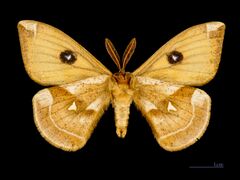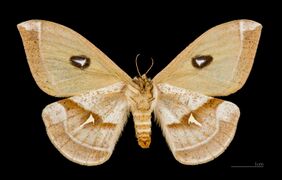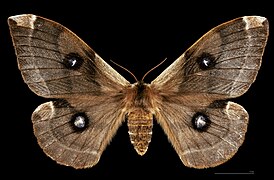Biology:Aglia tau
| Aglia tau | |
|---|---|

| |
| Scientific classification | |
| Domain: | Eukaryota |
| Kingdom: | Animalia |
| Phylum: | Arthropoda |
| Class: | Insecta |
| Order: | Lepidoptera |
| Family: | Saturniidae |
| Genus: | Aglia |
| Species: | A. tau
|
| Binomial name | |
| Aglia tau (Linnaeus, 1758)
| |
| Synonyms | |
| |
Overview
Aglia tau, the tau emperor, is a moth of the family Saturniidae. They are also known as giant silkmoths. It is found in Europe and across Central Asia to the Pacific coast.[1] The species was first described by Carl Linnaeus in his 1758 10th edition of Systema Naturae. Their genus, Aglia, is composed of 6 Palearctic (North European) species.
Size
The wingspan is 60–84 mm. The moth flies from March to July with a univoltine lifecycle depending on the location.
- Aglia tau
- Aglia tau f. melaina
Habitat
The larvae primarily feed on European beech, but also birch, Alnus glutinosa, Salix caprea and Sorbus aucuparia. The larvae look similar to Royal Walnut Moth caterpillars Citheronia regalis in their earlier instars. They can be found in older growth forests, with a large portion of trees in the Fagaceae family. They can also be found in younger riparian forests with less Fagaceae species present.
Lifecycle
Their life cycle is similar to any Lepidopterans, consisting of 4 stages. Eggs laid by adult females take about 3 weeks to hatch into first instar caterpillars. These grow quickly and go through 4 more instars, for 5 total. Then they spin a silken cocoon on the forest floor and pupate. These pupa will overwinter until March, until warmer weather comes and they start developing. Adult moths lack mouths and only breed. Then the adult females lay eggs then die.
References
- ↑ Naumann, Stefan; Brosch, Ulrich; Nässig, Wolfgang A. (2003). "A catalogue and annotated checklist of the subfamily Agliinae Packard, 1893 (Lepidoptera: Saturniidae) 1. Review of the Aglia species with description of a new taxon from Sichuan, China". Nachr. Entomol. Ver. Apollo, N. F. 24 (4): 173–182. https://www.zobodat.at/pdf/NEVA_24_0173-0182.pdf.
External links
| Wikimedia Commons has media related to Aglia tau. |
- Moths and Butterflies of Europe and North Africa
- Lepidoptera of Belgium
- Lepiforum e.V.
- Vlindernet.nl (in Dutch)
Wikidata ☰ Q1401296 entry
 |











